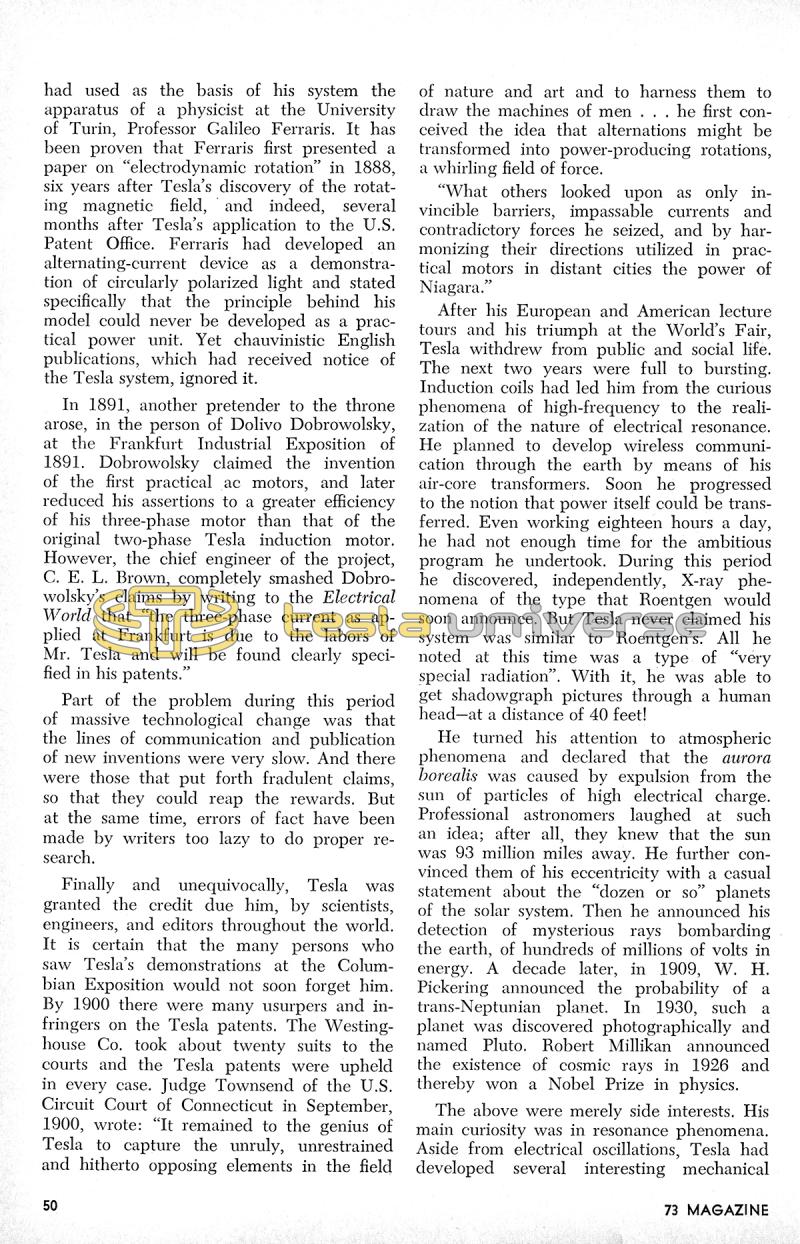
Nikola Tesla Articles
had used as the basis of his system the apparatus of a physicist at the University of Turin, Professor Galileo Ferraris. It has been proven that Ferraris first presented a paper on "electrodynamic rotation" in 1888, six years after Tesla's discovery of the rotating magnetic field, and indeed, several months after Tesla's application to the U.S. Patent Office. Ferraris had developed an alternating-current device as a demonstration of circularly polarized light and stated specifically that the principle behind his model could never be developed as a practical power unit. Yet chauvinistic English publications, which had received notice of the Tesla system, ignored it.
In 1891, another pretender to the throne arose, in the person of Dolivo Dobrowolsky, at the Frankfurt Industrial Exposition of 1891. Dobrowolsky claimed the invention of the first practical ac motors, and later reduced his assertions to a greater efficiency of his three-phase motor than that of the original two-phase Tesla induction motor. However, the chief engineer of the project, C. E. L. Brown, completely smashed Dobrowolsky's claims by writing to the Electrical World that "the three-phase current as applied at Frankfurt is due to the labors of Mr. Tesla and will be found clearly specified in his patents."
Part of the problem during this period of massive technological change was that the lines of communication and publication of new inventions were very slow. And there were those that put forth fradulent claims, so that they could reap the rewards. But at the same time, errors of fact have been made by writers too lazy to do proper research.
Finally and unequivocally, Tesla was granted the credit due him, by scientists, engineers, and editors throughout the world. It is certain that the many persons who saw Tesla's demonstrations at the Columbian Exposition would not soon forget him. By 1900 there were many usurpers and infringers on the Tesla patents. The Westinghouse Co. took about twenty suits to the courts and the Tesla patents were upheld in every case. Judge Townsend of the U.S. Circuit Court of Connecticut in September, 1900, wrote: "It remained to the genius of Tesla to capture the unruly, unrestrained and hitherto opposing elements in the field of nature and art and to harness them to draw the machines of men . . . he first conceived the idea that alternations might be transformed into power-producing rotations, a whirling field of force.
"What others looked upon as only invincible barriers, impassable currents and contradictory forces he seized, and by harmonizing their directions utilized in practical motors in distant cities the power of Niagara."
After his European and American lecture tours and his triumph at the World's Fair, Tesla withdrew from public and social life. The next two years were full to bursting. Induction coils had led him from the curious phenomena of high-frequency to the realization of the nature of electrical resonance. He planned to develop wireless communication through the earth by means of his air-core transformers. Soon he progressed to the notion that power itself could be transferred. Even working eighteen hours a day, he had not enough time for the ambitious program he undertook. During this period he discovered, independently, X-ray phenomena of the type that Roentgen would soon announce. But Tesla never claimed his system was similar to Roentgen's. All he noted at this time was a type of "very special radiation". With it, he was able to get shadowgraph pictures through a human head-at a distance of 40 feet!
He turned his attention to atmospheric phenomena and declared that the aurora borealis was caused by expulsion from the sun of particles of high electrical charge. Professional astronomers laughed at such an idea; after all, they knew that the sun was 93 million miles away. He further convinced them of his eccentricity with a casual statement about the "dozen or so" planets of the solar system. Then he announced his detection of mysterious rays bombarding the earth, of hundreds of millions of volts in energy. A decade later, in 1909, W. H. Pickering announced the probability of a trans-Neptunian planet. In 1930, such a planet was discovered photographically and named Pluto. Robert Millikan announced the existence of cosmic rays in 1926 and thereby won a Nobel Prize in physics.
The above were merely side interests. His main curiosity was in resonance phenomena. Aside from electrical oscillations, Tesla had developed several interesting mechanical
